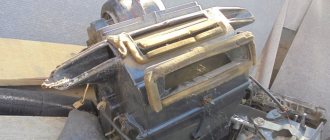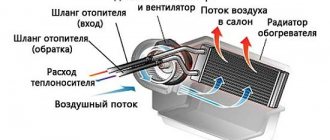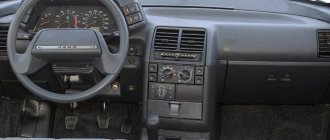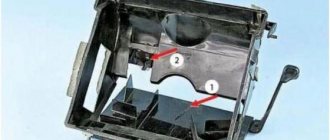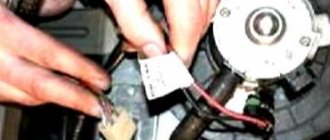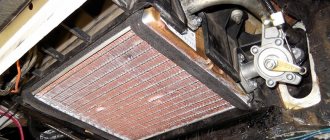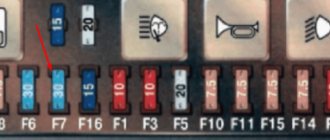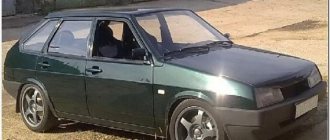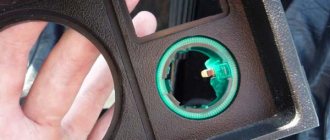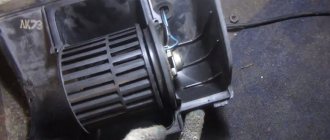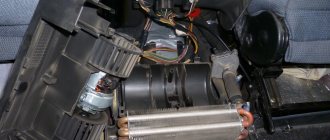Many car owners encounter problems with their heater while operating their car. Such breakdowns can be detected both in the summer, when the supply of fresh air from the street to the cabin stops, and in the winter, when the stove stops heating the car in cold weather. There may be several reasons for such malfunctions; individual breakdowns can be eliminated independently, without contacting a specialized service, thereby saving on car repairs.
Main symptoms of malfunctions
The main signs of stove malfunctions include the following:
1. Even when the engine is warm, cold air blows from the air ducts.
2. Heating efficiency is significantly reduced.
3. When you turn on the stove, crunching sounds are heard.
If the car owner notices these or other signs of a malfunction of the stove, it is necessary to either contact a service center or independently diagnose and repair the car.
Heater replacement
As a rule, the stove radiator is replaced in two cases: when it cannot be restored due to clogging or if it is rotten and has a leak. It happens that even a new heating part can leak. This is mainly due to poor quality materials of the purchased product.
You can replace the stove radiator at home. To do this, you need to follow the sequence of the repair process. It is important to note that repairs are easier to carry out with a partner. This paragraph indicates the process of dismantling and installing the Kalina stove.
Step-by-step dismantling process:
- First you need to drain about three liters of coolant.
- To easily dismantle the radiator, remove the accelerator pedal and lift the brake pedal as high as possible.
- The steering column is removed. First, remove the protective panels from the speaker. Then disconnect the electrical wiring plug from it.
- We disconnect the parts of the intermediate universal joint of the steering mechanism and unscrew the mounting bracket from the body. After this work, remove the entire steering column.
- We remove the “toad” of the stops, located on the right side of the brake pedal.
- Now, by hanging the brake and accelerator pedals in the upper position, we are able to access the radiator.
Before removing the stove, the following work must be carried out from the engine compartment. We remove the battery, its installation cavity and the base bracket. We disconnect the air filter pipe and bend it towards the passenger compartment. Then unscrew the coolant pipes from the fittings of the interior heater radiator. When removing the pipes, antifreeze may leak from the stove, which remains there in small quantities.
Working from the interior side, using a hacksaw blade for metal, we saw off the plastic pipes. Then the Kalina stove is removed along with the seal and metal protection element.
Causes of malfunction
If cold air is blowing from the stove or the efficiency of heating the air has significantly deteriorated, the causes of such breakdowns may be either a malfunction of the cooling system of the power unit or a malfunction of the stove itself. First of all, you need to check how the engine cooling system works. Remember that such malfunctions can lead to serious engine damage, including the need for a major engine rebuild.
You should check the antifreeze level in the expansion tank. If there are flakes in the antifreeze, and the coolant has lost its appearance, then it must be urgently replaced. It would also be a good idea to inspect the radiator pipes for leaks, which often occur at the junction of the radiator and the pipes. The weak point in the cooling system is the thermostat, this is a mechanical valve that directs antifreeze through a large or small circuit depending on the temperature of the coolant.
Another typical malfunction is the cooling system pump, which experiences increased load during operation. If it is determined that the cause of problems with the cooling system is the pump, then it should be replaced. Such malfunctions of the cooling system pump can be determined by the rapid heating of the engine, while the heater set to maximum will blow cold or barely warm air.
Why does the stove blow cold air?
Problems with the operation of the stove in the car interior can be expressed in the following:
- the stove blows cold air;
- the stove starts working if you press the gas pedal;
- the stove blows either cold or hot air;
- air stopped flowing from the deflectors into the cabin;
- the stove works, but cold air enters the cabin;
- fan operation is possible only if the speed regulator is moved to the extreme speed position;
- During operation of the stove, extraneous sounds are heard;
- hot air starts to blow when the crankshaft is running at high speeds.
Due to such malfunctions, not only does the air inside the car not heat up, but the engine as a whole does not function normally, which means the problem deserves special attention.
The reasons why the stove blows cold air can fall into one of two large groups.
1. Malfunctions of the cooling system as a whole.
- Thermostat.
Most often, the reason that the heater in your car is blowing cold air is a broken thermostat or switch. Thanks to this element, the coolant moves in the right direction. If the thermostat fails, antifreeze will pass through the main radiator, the time required to warm up the engine will increase significantly, and if the air temperature is low, it will not warm up.
A malfunction of the thermostat is primarily indicated by the coolant temperature indicator. If the element is faulty, it will take a long time for the antifreeze temperature to rise. In addition, you can feel the hose that comes from the main radiator. If, after warming up the engine, the hose does not heat up and the heater blows cold air, then we can conclude that the thermostat has failed and needs to be replaced.
- Water pump.
Another reason that the stove is blowing cold air may be the ineffective operation of the pump - the pump that pumps antifreeze. Pump failure is possible in the following cases:
— malfunction of its drive (belt break);
— jamming (bearing failure);
- rotation of the impeller (blades that drive coolant) or its destruction, as a result of which it will not be able to effectively pump coolant.
Recommended articles to read:
- Repair Citroen C4 sedan: diagnostic tips
- Automatic transmission Citroen C4 sedan: operating instructions
- Selling a Citroen: how to do it most profitably?
As a result, the system will not warm up evenly - if one part overheats, the other will remain cold, which will lead to overheating of the engine. The antifreeze temperature sensor will indicate a malfunction.
If the pump is ineffective, the heater will operate at high engine speeds. The volume of coolant passing through the radiator at idle speed will not be enough for warm air to blow from the stove.
- Cylinder head gasket.
A nailed or burnt gasket, which is located between the cylinder block and its head, allows gases in the cylinders to enter the coolant.
This malfunction can be judged by white smoke coming out of the exhaust pipe, a sharp increase in the level of antifreeze, as well as gurgling sounds in the expansion tank. This malfunction is quite serious and requires disassembling the engine.
- Air in the system.
The operation of the heater at high engine speeds indicates the presence of air in the cooling system. Air has low thermal conductivity and is therefore not suitable for the rapid spread of heat. This situation adversely affects not only the operation of the stove, but also the functioning of the engine as a whole.
Due to the design features of the stove, air accumulates in the area of its radiator. If the antifreeze does not move intensively enough, for example, when the engine is idling, the coolant does not expel air from the radiator, and the heater blows cold air.
The entry of air into the system is indicated by poor operation of the heater at low speeds, and when they increase, you will not only feel a blow of hot air, but also gurgling sounds in the area of the stove. First of all, the cause of air entering the system should be determined. This may be due to insufficient tightness of the system, leading to air suction, or to a small volume of antifreeze. But before bringing its quantity to normal, it is important to find out and eliminate the reason for the decrease in its volume.
If the heater's radiator has been replaced, but it continues to blow cold air, air has most likely entered the system. To resolve this problem, please refer to the operating instructions for your specific vehicle. To eliminate the air lock that has formed in the heater radiator, it is necessary to disconnect the hoses, then pour coolant into the upper one, while it will pour out through the lower one. The procedure must be continued until air bubbles stop coming out of the hose.
On a number of cars, you can get rid of air in the heating system by placing the car at a certain angle and starting the engine at high speeds.
2. Malfunctions of the heating system.
If the heater blows cold air while running and there are no faults in the cooling system, most likely the problem is in the heater itself. That is, the coolant reaches it, but cannot penetrate into the cabin in the form of hot air. The malfunction may concern the radiator or heater tap.
- Heater radiator.
If the heater blows cold air at speed, the problem may be a clogged heater core. The blockage prevents hot coolant from passing through it, therefore the air does not heat up. This situation is possible in the following cases:
— use of various cooling system sealants;
— long-term operation of the car using low-quality antifreeze or water;
— the car and radiator are of considerable age.
The listed reasons lead to the accumulation of dirt in the cooling system. Since the channels in the stove radiator are the narrowest (due to the need for slower fluid flow and greater heat transfer), they are most susceptible to contamination. The problem can be corrected by flushing or replacing the radiator.
- Faucet.
Another reason that the heater is blowing cold air may be a closed heater tap. This problem occurs in older cars. The situation is possible if there is a malfunction of the faucet itself, which is stuck in the closed position, or in the control drive.
In the latter case, the reason lies in the drive (cable) coming off the mounts. In this case, it must be returned to its place and secured. The faucet is replaced as an assembly. Modern vehicle models do not have faucets; they are equipped with dampers that close the radiator when there is no need for hot air. If the damper fails, the stove also stops functioning normally.
Heater fan repair
Another typical reason for a heater failure in a car is a failure of the heater fan. Typically, such breakdowns manifest themselves not only in a significant decrease in the efficiency of air heating, but at the same time clanging sounds and squeaks may appear, which indicates the presence of problems with the fan bearing.
The complexity of such repairs is explained by the fact that it is often necessary to disassemble the dashboard to replace the fan, and this is a complex and time-consuming job that can only be done by a specialist who is well aware of the design features of a particular car. However, if the car owner knows where the heater fan is located, if desired, you can independently disassemble the central panel and dashboard, replacing the failed parts.
23.03.2021
Interior heater. Work and device
The vehicle interior heating system includes an electric fan, cooling fluid supply and circulation pipes, a radiator, shut-off valves, air ducts and air dampers. The heating element is located in the front panel housing.
For the system to operate effectively in winter, the engine must be warmed up well. Thirty degrees is enough for the heater to supply warm air into the cabin. Turning on the system immediately after starting the engine will only increase the warm-up time of the engine and the interior itself.
